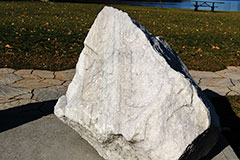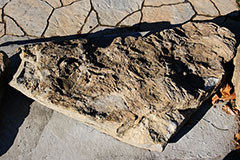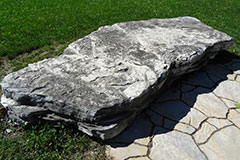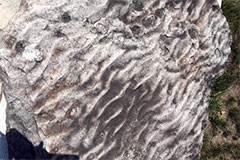In places along the sides of this rock it feels like hard sandpaper. And so sandstone should!
Photo by Brent Eades.
This sample and display rock 12 to the right are georescue specimens from Highway 417 in Kanata. Full story at http://millstonenews.com/2012/11/metcalfe-geoheritage-park-receives-rescue-rocks.html
In what setting was the sand of this display rock deposited?
The fine to coarse sand, which was later cemented together to form this rock, was deposited during the early Ordovician Period, as recently as about 488 million years ago. It is the earliest (or oldest) rock formation of the early Paleozoic Era in eastern Ontario that was formed under marine conditions. The sand was deposited in near-shore coastal environments as the ocean level gradually rose to cover much of the continent.
To read more about the geological setting of the Nepean sandstone formation, and the environment of the Ordovician Period, check out the information on display rocks 7, 8 and 9.
Some things to look for
crossbedding Inclined layers of sand grains are formed downstream by water or wind transport.
evaporate moulds Salt minerals, formed by the evaporation of sea water, were later buried by accumulating sediments, dissolved, and replaced to create moulds of the original crystal shape.
glacial striations Scratches or gouges were cut into the bedrock by small pebbles that were pushed / pulled along under high pressure beneath a moving glacier.
ripple marks Wavy ridges and furrows can be created in shallow water conditions by wave action. Be sure to see the ripple marks of specimen 18 too.
What is this rock used for?
The Nepean Formation is a source of aggregate, cement, building stone1 and groundwater used for drinking water. In fact, this sandstone was used to build some of our most important cultural buildings. From the book, Ottawa’s Building and Monument Stones2, we learn that these next iconic buildings are all made with Nepean sandstone: the War Museum; the Royal Canadian Mint; and the Parliament Buildings.

Cropped public domain photo by RealGrouchy via Wikimedia Commons.
The Victoria Memorial Museum Building, now the Canadian Museum of Nature, was opened to the public in 1912.3 It too was constructed with Nepean Sandstone.
1 Easton, R.M. 1992. Geology, Eastern Ontario, Paleozoic and Mesozoic Geology of Ontario; in Geology of Ontario, Ontario Geological Survey, Special Volume 4, Part 2, p. 915-918
2 Gall, Q. 2011, A Walking Guide: Ottawa’s Building and Monument Stones; Geological Association of Canada
3 http://www.ottawacitizen.com/news/museum/photos+building+museum+nature/3018886/story.html (05.12.2010)























